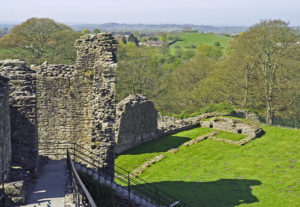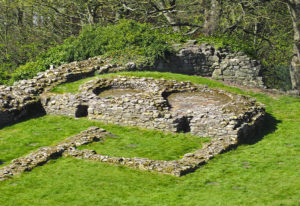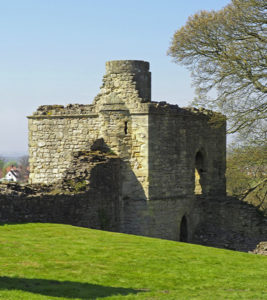Standing on high ground above the marsh valley bottom, Pickering was an important pre-Norman conquest settlement controlling the main north south route from Whitby to Malton and the east west route between Scarborough and Northallerton. As part of his attempt to subdue the rebellious North, William I ordered a motte and bailey castle to be constructed here. At the top of the settlement, it would have had commanding views across the area.
A curtain wall was built at the end of the C12th by Henry II, enclosing an inner ward, entered by the Coleman Tower. William’s wooden castle was replaced by a stone shell keep by Henry III at the start of the C13th after increasing trouble with rebellious nobles in the north of England and the Scots. The outer curtain wall with three towers enclosing the outer ward was added at the start of the C14th by Edward II.
The castle never had a major military significance and was used as a royal hunting lodge for the deer and wild boar found in the adjacent royal forests. By the mid C16th, it was no longer used and played no role in the English Civil War. It was gradually plundered for building stone and became an abandoned ruin. The chapel continued in use as a legal court long after the castle was abandoned and is the only structure still in good repair.
Pickering Castle is one of the best examples of a motte and bailey castle in England with a shell keep and is surrounded by a curtain wall enclosing outer and inner wards. The curtain wall still stands to nearly its original height and is protected by a dry ditch. Walking round the outside of the castle, the latrine chutes and holes used for scaffolding erected during building, can still be seen.
Visitors still enter through the gatehouse into the Outer Ward. This would have had drawbridge, portcullis and sturdy double doors. Nothing is left of the stables which would have been built along the inside of the wall.
The large square Mill Tower stands at the south western corner of the outer ward. This may have taken its name from a horse mill in the corner of the outer ward or from a water mill in Pickering Beck below. At the beginning of the C17th this was used as a prison tower with the gaoler living on the first floor.
The northern most of the three curtain wall towers is the Rosamund Tower on the north east wall where the inner and outer wards join. This had a small postern gate leading into the dry ditch.
The inner ward and its wall are protected by another dry ditch with entry via the Coleman Tower protected by a drawbridge and portcullis. The ground floor of the Coleman Tower was probably used used as a prison for offenders against the forest laws as well as petty criminals and robbers. The upper floors would have housed the soldiers.
The grassy motte is surrounded by another dry ditch and the well is here. Stone steps lead up to the shell keep on top of the motte. This was known as the King’s Tower in the C14th and would have provided secure lodgings for the king. The foundations of some of the buildings can still be see in the grass. By Tudor times it was in ruins and no longer used. It is worth climbing up for views down onto the castle grounds.
The inner ward contained the domestic buildings with kitchens, food stores and brewhouse. only foundations are left, although the base of the circular ovens of the brew and bake house is still clearly visible.
The chapel is the only part of the castle to survive and dates from the C13th. Next to it are the foundations of the New Hall, or King’s Hall. This was built in the early C14th to replace an earlier old hall on the other side of the chapel.
Pickering Castle came into ownership of the Office of Works in 1926 and now belongs to English Heritage. The castle is open daily from March – October but is closed during the winter. It is well worth visiting if in Pickering. It is possible to scamper round in 30 minutes but to enjoy the site properly allow at least an hour.
There are more pictures “here.”:http://wasleys.org.uk/eleanor/castles/england/yorkshire/pickering/index.html










